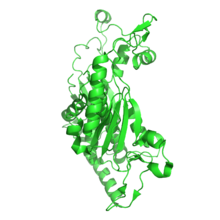- Chorismate synthase
-
 Ribbon diagram of the 1ZTB structure, Chorismate synthase isolated from Mycobacterium tuberculosis. [1]
Ribbon diagram of the 1ZTB structure, Chorismate synthase isolated from Mycobacterium tuberculosis. [1]
chorismate synthase Identifiers EC number 4.2.3.5 CAS number 9077-07-0 Databases IntEnz IntEnz view BRENDA BRENDA entry ExPASy NiceZyme view KEGG KEGG entry MetaCyc metabolic pathway PRIAM profile PDB structures RCSB PDB PDBe PDBsum Gene Ontology AmiGO / EGO Search PMC articles PubMed articles In enzymology, a chorismate synthase (EC 4.2.3.5) is an enzyme that catalyzes the chemical reaction
- 5-O-(1-carboxyvinyl)-3-phosphoshikimate
 chorismate + phosphate
chorismate + phosphate
Hence, this enzyme has one substrate, 5-O-(1-carboxyvinyl)-3-phosphoshikimate, and two products, chorismate and phosphate.
This enzyme belongs to the family of lyases, specifically those carbon-oxygen lyases acting on phosphates. The systematic name of this enzyme class is 5-O-(1-carboxyvinyl)-3-phosphoshikimate phosphate-lyase (chorismate-forming). This enzyme is also called 5-O-(1-carboxyvinyl)-3-phosphoshikimate phosphate-lyase. This enzyme participates in phenylalanine, tyrosine and tryptophan biosynthesis.
Chorismate synthase Identifiers Symbol Chorismate_synt Pfam PF01264 InterPro IPR000453 PROSITE PDOC00628 SCOP 1q1l Available protein structures: Pfam structures PDB RCSB PDB; PDBe PDBsum structure summary Chorismate synthase catalyzes the last of the seven steps in the shikimate pathway which is used in prokaryotes, fungi and plants for the biosynthesis of aromatic amino acids. It catalyzes the 1,4-trans elimination of the phosphate group from 5-enolpyruvylshikimate-3-phosphate (EPSP) to form chorismate which can then be used in phenylalanine, tyrosine or tryptophan biosynthesis. Chorismate synthase requires the presence of a reduced flavin mononucleotide (FMNH2 or FADH2) for its activity. Chorismate synthase from various sources shows[2][3] a high degree of sequence conservation. It is a protein of about 360 to 400 amino-acid residues.
Structural studies
As of late 2007, 9 structures have been solved for this class of enzymes, with PDB accession codes 1Q1L, 1QXO, 1R52, 1R53, 1SQ1, 1UM0, 1UMF, 1ZTB, and 2G85.
References
- ^ 1ZTB Dias; et al. (2006). "Structure of chorismate synthase from Mycobacterium tuberculosis". J. Structural Biology 154: 130–143.; rendered with PyMOL
- ^ Schaller A, Schmid J, Leibinger U, Amrhein N (1991). "Molecular cloning and analysis of a cDNA coding for chorismate synthase from the higher plant Corydalis sempervirens Pers". J. Biol. Chem. 266 (32): 21434–21438. PMID 1718979.
- ^ Braus GH, Reusser U, Jones DG (1991). "Molecular cloning, characterization and analysis of the regulation of the ARO2 gene, encoding chorismate synthase, of Saccharomyces cerevisiae". Mol. Microbiol. 5 (9): 2143–2152. doi:10.1111/j.1365-2958.1991.tb02144.x. PMID 1837329.
- Gaertner FH, Cole KW (1973). "Properties of chorismate synthase in Neurospora crassa". J. Biol. Chem. 248 (13): 4602–9. PMID 4146266.
- Morell H, Clark MJ, Knowles PF, Sprinson DB (1967). "The enzymic synthesis of chorismic and prephenic acids from 3-enolpyruvylshikimic acid 5-phosphate". J. Biol. Chem. 242 (1): 82–90. PMID 4289188.
- Welch GR, Cole KW, Gaertner FH (1974). "Chorismate synthase of Neurospora crassa: a flavoprotein". Arch. Biochem. Biophys. 165 (2): 505–18. doi:10.1016/0003-9861(74)90276-8. PMID 4155270.
- Bornemann S, Lowe DJ, Thorneley RN (1996). "The transient kinetics of Escherichia coli chorismate synthase: substrate consumption, product formation, phosphate dissociation, and characterization of a flavin intermediate". Biochemistry. 35 (30): 9907–16. doi:10.1021/bi952958q. PMID 8703965.
- Bornemann S, Theoclitou ME, Brune M, Webb MR, Thorneley RN, Abell C (2000). "A Secondary beta Deuterium Kinetic Isotope Effect in the Chorismate Synthase Reaction". Bio-Organic. Chemistry. 28 (4): 191–204. doi:10.1006/bioo.2000.1174. PMID 11034781.
- Osborne A, Thorneley RN, Abell C, Bornemann S (2000). "Studies with substrate and cofactor analogues provide evidence for a radical mechanism in the chorismate synthase reaction". J. Biol. Chem. 275 (46): 35825–30. doi:10.1074/jbc.M005796200. PMID 10956653.
This EC 4.2 enzyme-related article is a stub. You can help Wikipedia by expanding it. - 5-O-(1-carboxyvinyl)-3-phosphoshikimate
